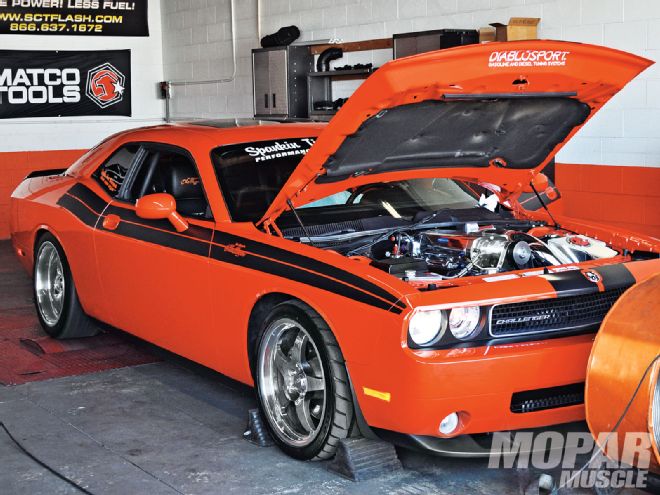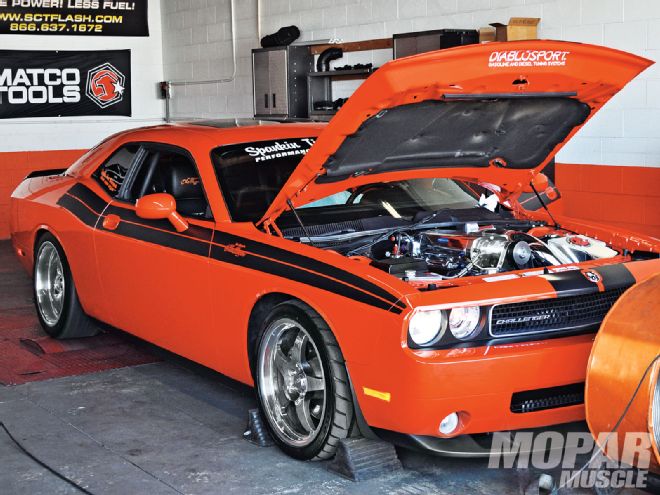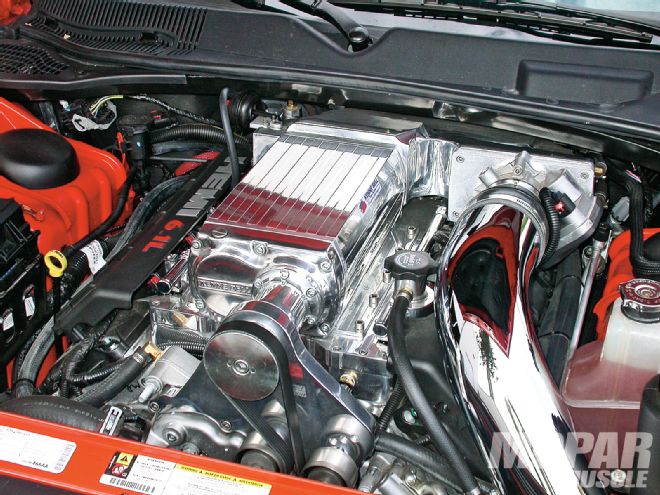

It's no surprise that the new Hemi is an impressive power plant, and a worthy successor to its legendary namesake. From the pedestrian 5.7 all the way up to the new 6.4, the Hemi is more than a match for anything offered by Ford or Chevy. Credit goes to the cylinder heads and an efficient intake design for the majority of the power. The tremendous flow rate of the heads and intake allow the factory Hemi to produce prodigious power with mild cam timing. The Hemi is literally begging for more aggressive cam timing, but fuel economy, emissions and idle quality concerns all dictate mild cam timing for factory engines. Given the airflow potential, one route to improved factory performance is increased displacement. Chrysler took this route with the new 6.4 Hemi to the tune of 475 horsepower. If 400 is good, then 800 horsepower must be even better, and the only thing better than 800 is 1,000 horsepower. Are you starting to get the picture?
Time and technology have marched on, and it seems that 1,000 hp is the new 500. Some might argue the necessity of 1,000-horsepower street cars, but the additional power is always useful given the excessive curb weight of Hemi-powered machinery (our Challenger tipped the scales at a portly 4,610 pounds! It takes a ton of power to get anything that heavy moving with authority, so the guys ST Motorsports set out to build one hellacious supercharged Hemi. The horsepower goal was an honest 1,000 (flywheel) horsepower, but every bit as important was the fact that said four-digit power plant must also double as a street machine. Race fuel was not eliminated as a track option, but suitable street manners were considered mandatory. With Kenne Bell's involvement, supercharging was a given, but 1,000 horsepower doesn't come from boost alone. The elevated power goals required attention to every component of the proposed power plant.
Normally aspirated engines run at atmospheric pressure. It is the pressure differential between the cylinder and outside air created by the downward moving piston that fills the cylinder. Superchargers enhance this cylinder filling-ability by increasing the pressure differential. Under the right circumstances, doubling the pressure supplied (14.7 psi of boost), can double the power output. A portion of this power is lost to drive the supercharger, but boost enhances the power output of the normally aspirated combination. The great thing about boost is that applying 14.7 psi can nearly double the power output of the normally aspirated combination, irrespective of the original power output. Thus, it should be obvious that a great supercharged combination always starts out as a healthy normally aspirated engine. The more powerful the normally aspirated combination, the greater the output offered by the supercharged configuration at any given boost level. Using this logic, it is much easier to reach a given power level at a reduced boost pressure. Lower boost levels (usually) increase blower efficiency and decrease inlet air temperatures (further increasing power), which in turn reduces the likelihood of harmful detonation.
Obviously, Adam Montague at ST Motorsports www.spankintime.com) understood this simple principle before starting the build. The first order of business was to build a Hemi capable of withstanding the 20-plus psi of boost that it was going to take to achieve the power goal. Stock Hemis are tough, but not 20-plus psi of boost tough. Starting with a 6.1, the first order of business was to increase the displacement. When it comes to power production, bigger is obviously better, so the 6.1 was punched and stroked out to 6.4 liters (393 inches) courtesy of a 3.795-inch SCAT crankshaft www.scatcrankshafts.com), 6.20-inch K1 rods www.k1technologies.com), and a set of 4.06-inch forged pistons from CP www.cp-carrillo.com). The forged rotating assembly increased both strength and displacement, which are both welcome when searching for 1,000 hp. Naturally, balancing, new rings and bearings were all part of the program. When completed, the assembled short block featured a 10.6: static compression. Some might consider this a tad on the high side for forced induction, but the reality is that the compression improves both (off-boost) mileage and power. Since all high-boost runs were made on race fuel, why give away the horsepower by dropping the compression a point or two?
 7. The big power adder was obviously the Kenne Bell supercharger kit. Even on a stock 6.1, the Kenne Bell twin-screw supercharger offered exceptional performance, to the tune of 175 horsepower.
7. The big power adder was obviously the Kenne Bell supercharger kit. Even on a stock 6.1, the Kenne Bell twin-screw supercharger offered exceptional performance, to the tune of 175 horsepower.
With more displacement, it was time to increase airflow. The stock cam was ditched in favor of a more aggressive hydraulic roller from Crower Cams www.crower.com). The dual-pattern cam featured a .587/.597-inch lift, a 235/243-degree duration (at .050-inch), and a blower-friendly 114-degree lobe separation angle. The high lift cam was designed to work with a set of high-flow heads supplied by Inertia Motorsports www.nertiamotorsports.com). The 6.1 heads featured full porting, increased valve sizes and a revised spring package to eliminate valve float. Providing the majority of the flow to the Hemi is a Kenne Bell www.kennebell.com) twin-screw supercharger. The stock 2.8 Kenne Bell kit adds 175 horsepower and 135 lb/ft of torque to an auto-equipped 6.1. Looking for big power numbers, they opted to replace the smaller 2.8L with a massive 3.6L blower. The difference between the 2.8 and 3.6 is size (displacement). Both are offered with liquid cooling and Seal Pressure equalization. The 3.6 is longer and slightly taller than the 2.8 unit. A larger rotor pack means more airflow per revolution. This equates to an increase in maximized flow and boost potential. Capable of supporting 1,200 horsepower on the right application, the 3.6L also featured patented Liquid Cooling (not to be confused with intercooling). Liquid Cooling stabilized the temperature differential that exists between the cool inlet and heated discharge sides of the supercharger.
Liquid Cooling enhanced both longevity and performance of the supercharger, while an air-to-water intercooler system greatly reduces the inlet air temps. The Kenne Bell kit featured both Liquid Cooling (of the blower) and an air-towater intercooler. Liquid Cooling was used to cool the heated (discharge) side of the supercharger by circulating water though dedicated passages in the front of the blower. This helps control the difference in rotor growth between the hot (discharge) and cool (inlet) sides of the blower. It is desirable for the rotors to grow evenly front to back, in order to maintain proper tolerances. Intercooling is used to reduce the temperature of the boosted intake air. Heat is a natural byproduct of compression, so any boost provided to the motor will heat the air. The greater the boost pressure, the higher the charge temperature. Higher intake charge temperatures both reduce power and increase the likelihood of harmful detonation. Running the boosted air through a heat exchanger located under the blower dramatically reduces the intake charge temperature (by as much as 200 degrees), thus increasing power and reducing detonation. Using intercooling, makes it possible to run higher boost/power levels on any given octane rating (pump gas).
With the major components taken care of, it was time to address a few secondary systems, namely air intake and fuel flow. Air flow into the supercharger has a direct affect on the boost level coming out. Maximizing airflow to the blower is a 4.5-inch air intake system, a massive single-blade throttle body (flowing 2,150 cfm) and a Mammoth intake manifold all from Kenne Bell. Fuel was supplied by a pair of 255 ltr/hr fuel pumps augmented by a dual Kenne Bell 17V Boost-a-Pump, feeding eighty-pound injectors. Though boost was increased gradually after the break-in period, the Kenne Bell supercharger was eventually configured to produce 23 psi of boost using a 3.375-inch blower pulley and a 7.5-inch crank pulley. Running 23 psi, the supercharged street stroker pump out 989 horsepower at the wheels (well over 1,000 flywheel hp), and 907 lb/ft of torque. Track testing the Challenger with 18 psi of boost resulted in a best et of 9.96 seconds at nearly 139 mph. Future changes include a change to E85 fuel and testing with an even larger 4.2L blower. We are not sure what Webster or Wikipedia would say,
61 Cylinder Head Flow Numbers .100 73 52 .200 165 120 .300 231 181 .400 278 214 .500 311 231 .600 344 236 .700 358 239